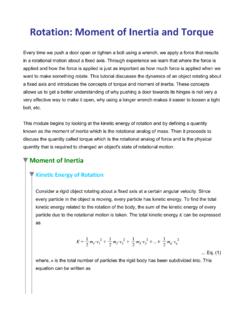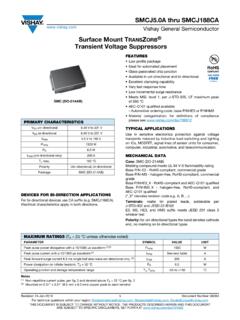Transcription of Transfer Functions, Poles and Zeros - Waterloo Maple
1 Transfer Functions, Poles and ZerosFor the design of a control system, it is important to understand how the system of interest behaves and how it responds to different controller designs. The Laplace transform, as discussed in the Laplace Transforms module, is a valuable tool that can be used to solve differential equations and obtain the dynamic response of a system. Additionally, the Laplace transform makes it possible to obtain information relating to the qualitative behavior of the system response without actually solving for the dynamic response . The Poles and Zeros of a system, which are the main focus of this module, provide information on the characteristic terms that will compose the response . This is very useful because it allows a control system designer to understand how the design parameters can be manipulated to obtain acceptable response characteristics.
2 Using a graphical trial and error approach called the root-locus design method, the designer can alter the design parameters to values that lead to an acceptable response and then verify the design by solving for the time response of the module is a continuation of the Laplace Transforms module and provides an introduction to the concept of Transfer functions and the Poles and Zeros of a system. (This command loads the functions required for computing Laplace and Inverse Laplace transforms) Transfer FunctionsA Transfer function is defined as the following relation between the output of the system and the input to the system .. Eq. (1)If the Transfer function of a system is known then the response of the system can be found by taking the inverse Laplace transform of . It is also important to note that a Transfer function is only defined for linear time invariant systems with all initial conditions set to the input to the system is a unit impulse (), Eq.
3 (2)Therefore, the inverse Laplace transform of the Transfer function of a system is the unit impulse response of the system. This can be thought of as the response to a brief external disturbance. Example 1: Transfer function of a Spring-mass system with viscous dampingProblem Statement: The following differential equation is the equation of motion for an ideal spring-mass system with damping and an external force Find the Transfer 1: Spring-mass system with dampingSolutionTaking the Laplace transform of both sides of the equation of motion givesThis equation can be rearranged to getTherefore, the Transfer function for this system is( )( )( )( )The system response can be found be taking the inverse Laplace transform of . If and the input is a step function , then the system response isExample 2: Transfer function of a DC Motor (with MapleSim)Problem Statement: A DC motor is modeled using the equivalent circuit shown in Fig.
4 The Transfer function relating the angular velocity of the shaft and the input voltage. Fig. 2: DC Motor modelThis example demonstrates how to obtain the Transfer function of a system using SolutionThe equivalent circuit consists of a voltage source which is the input, a resistor, an inductor and a "back EMF" voltage source. The back EMF depends on the rate of rotation and can be expressed aswhere is a constant of proportionality called the electric constant and is theangular speed. The torque on the rotor is proportional to the armature current and can be expressed as where is a constant of proportionality called the torque constant. It should be noted that the electric constant and the motor constant are equal to each other when expressed in the same units (. The dynamic equation for the circuit iswhere is the input voltage, is the resistance of the resistor and is the inductance of the inductor.)
5 The Laplace transform of this equation Eq. (3)The dynamic equation for the rotor iswhere is the moment of inertia of the rotor and b is the damping constant. The Laplace transform of this equation Eq. (4)Combining Eqs. (3) and (4) and eliminating yieldsThis equation can be rearranged to obtain the required Transfer function:Solution using MapleSimConstructing the modelStep 1: Insert ComponentDrag the following components into the workspace:Table 1: Components and locationsComponentLocationSignal Blocks > CommonElectrical > Analog > Sources > Voltage Electrical > Analog > CommonElectrical > Analog > CommonElectrical > Analog > CommonElectrical > Analog > Common1-D Mechanical > Rotational > Common1-D Mechanical > Rotational > Common1-D Mechanical > Rotational > Common1-D Mechanical > Rotational > SensorsStep 2: Connect the componentsConnect the components as shown in the following diagram:3.
6 3. 7. 7. 4. 4. 1. 1. 6. 6. 2. 2. 5. 5. Fig. 3: Component diagramStep 3: Create a subsystemHighlight all the components, excluding the Step Ctrl+G to create the subsystem. Name the subsystem DCMotor and click click the subsystem and click Add or Change Parameters in the inspector the parameters as shown below. Fig. 4: ParametersReturn to the subsystem component diagram and enter these variables for thecorresponding parameters of the components. For example, click theResistor component and enter for the Resistance () in the Inspector tab. Click the output of the Angle Sensor component and connect it to the dashedline that represents the boundary of the subsystem. 5. 5. 4. 4. 1. 1. 6. 6. 2. 2. 3. 3. 7. 7. Fig. 5: SubsystemObtaining the system equationsClick the Create attachment from template icon ().
7 Select Equations from the list and click Create Attachment. This will launch a Maple the launched worksheet, select the DCMotor subsystem in the drop-down menu for Step 1: Subsystem Selection and then click Load Selected DAE Variables rename the variables to simplify the equations. Rename I2_phi(t), I2_w(t),SV1_n_v(t), emf1_p_i(t) and u1(t) as phi(t), w(t), v(t), i(t) and u(t) respectively. Click Reassign down to Step 2: View Equations. These are the dynamic equations for the subsystem and are assigned to the variable down to the bottom of the work sheet and execute the following commands to obtain the system Transfer function. Fig. 6: System Transfer FunctionThis Transfer function matches the one obtained and ZerosZeros are defined as the roots of the polynomial of the numerator of a Transfer function andpoles are defined as the roots of the denominator of a Transfer function.
8 For the generalized Transfer function .. Eq. (5)The Zeros are and the Poles are Identifying the Poles and Zeros of a Transfer function aids in understanding the behavior of the system. For example, consider the Transfer function .This function has three Poles , two of which are negative integers and one of which is zero. Using the method of partial fractions, this Transfer function can be written as and its time response (with a unit impulse input) can be found to be . This shows that the negative Poles contribute exponentialterms that decay with time and that the pole at 0 contributes a constant term. If we take another Transfer function, for example , without solving for the solution, we can now conclude that the pole at 0 will contribute a constant term, the negative pole will contribute a term that decays with time and the positive pole will contribute a term that grows with time.
9 This allows us to further conclude that the response will be unstable because it will continuously grow with time due to the positive pole. The following plot shows the time response of . response Plot response PlotNow consider the Transfer function . This function also has three Poles , however, two of these are complex. Using the method of partial fractions, this can be written as and the time response (with a unitimpulse input) can be found to be . This shows that the complex Poles contribute sinusoidal terms and result in oscillations in the system response . These examples illustrate that the location of the Poles on a complex plane can help obtain a qualitative understanding of characteristics of the time response . The following plot showsthe Poles of the Transfer functions of and plotted on the complex plane (or the s-plane).
10 ( )( )The interactive plots given below can be used to better understand the effect of pole locations on a system's response . The following plot shows the transient response of a system with two real Poles for a unit-impulse input and a unit-step input. One of these Poles is fixed at and the other can be dragged on the real axis to see the effect on the response . The following plot shows the transient response of a system with a real pole and a pair of complex Poles for a unit-impulse input and a unit-step input. These Poles can be dragged onthe s-plane to see the effect on the response . The following plot shows the transient response of a system with a real zero and a pair of complex Poles for a unit-impulse input and a unit-step input. The response of the system without the zero is also included for comparison.






